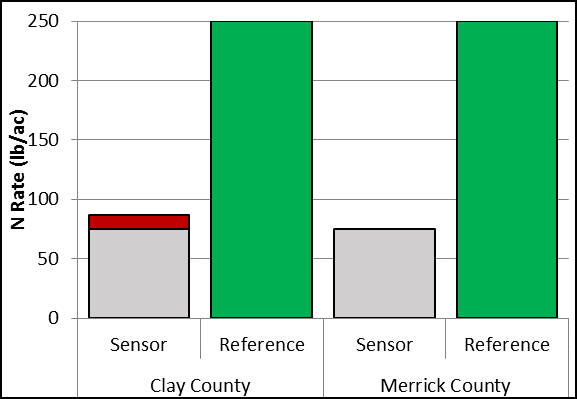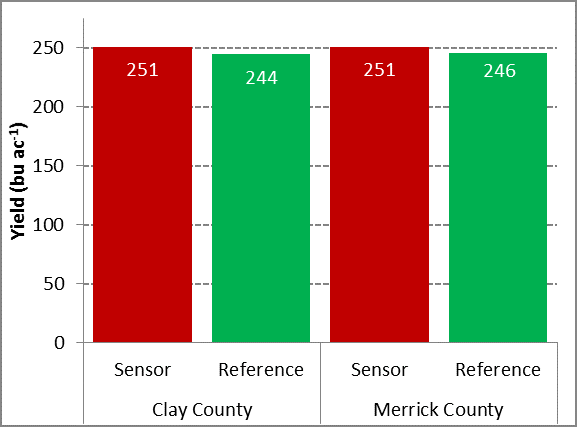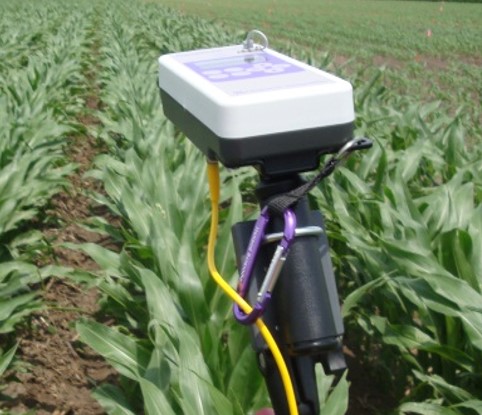The Nebraska On-Farm Research Network is launching a new project focused on improving the efficiency of nitrogen fertilizer use. Project SENSE (Sensors for Efficient Nitrogen Use and Stewardship of the Environment) will implement 20 on-farm research sites each year, over the next 3 years. Richard Ferguson, UNL Extension Soil Specialist, is leading the project which will focus on crop canopy sensors to direct variable-rate, in-season nitrogen application in corn. Since 1988, the nitrate concentration in groundwater in Nebraska's Central Platte River Valley has been steadily declining, largely due to the conversion from furrow to center-pivot irrigation. However, over the last 25 years, fertilizer nitrogen use efficiency has remained static. This trend points to the need for adoption of available technologies such as crop canopy sensors for further improvement in nitrogen use efficiency. Strategies which direct crop nitrogen status at early growth stages are promising as a way to improve nitrogen fertilizer efficiency.
Managing Variability with Sensors
It is difficult to determine the optimum amount of nitrogen to apply in a field; nitrogen needs in a field vary spatially and from year to year. Because crop canopy sensors are designed to be responsive to nitrogen needs, they can help account for this variability. Another challenge with nitrogen management is that all the nitrogen for the crop is often applied prior to the growing season, before the crop begins to rapidly uptake nitrogen. This results in unnecessary losses of nitrogen from the cropping system and has negative economic and environmental implications. Applying a portion of the total nitrogen during the growing season helps better match nitrogen availability to the time the crop uptakes nitrogen.
A study done in central Nebraska in 2012 demonstrates the ability of crop canopy sensors to improve nitrogen recommendations by making in-season nitrogen recommendationsi. A sensor-based treatment had an initial 75 lb/acre of nitrogen applied at the beginning of the growing season (grey bar) (Figure 1). For comparison, a reference treatment had 250 lb/acre of nitrogen also applied at the beginning of the season (green bar). At V8 growth stage, the crop canopy was sensed and additional nitrogen was applied to the sensor treatments according to the sensor recommendation (red portion of the bar). For these two sites in 2012, very little in-season nitrogen was recommended – 12 lb/acre at Clay County and 0 lb/acre at Merrick County. The yield for these two sites is shown in Figure 2. There was no significant difference in yield between the reference treatment and the sensor treatments. Growing conditions in 2012 resulted in high levels of mineral nitrogen becoming available to the crop during the growing season. Because the sensor is responsive to the unique growing conditions in this year, 163 and 175 lb of nitrogen/acre were saved for Clay County and Merrick County sites respectively.


How Sensors Work

Active sensors work by emitting light onto the crop canopy and then measuring reflectance from the canopy with photodetectors. The light source simultaneously emits visible and near infrared light, which is detected synchronously by sensor electronics. When used to detect plant health, light in both the visible (VIS; 400-700 nm) and near-infrared (NIR; 700-1000 nm) portions of the electromagnetic spectrum are generally measured. These wavelengths are combined to create various vegetation indices (VI), such as the commonly used normalized difference vegetation index (NDVI), that are correlated with specific crop conditions of interest. Algorithms are then used to translate the NDVI values into an in-season nitrogen recommendation rate.
Challenges in Adoption
A study in Missouri conduced on 55 sites compared sensor determined nitrogen rates to producer determined nitrogen ratesii. The study found that using sensors to determine nitrogen rate reduced the amount of nitrogen that was applied by 14 lb/acre and increased profit by $17/acre averaged over all locations. The increase in profit was due to both reduced nitrogen use and increased yield. However, despite the benefits of sensors for nitrogen management, the adoption of the technology has been slow. One of the challenges to the adoption of crop canopy sensors may be the high startup costs involved in adopting this technology. Additionally, there is little opportunity for producers to experiment and try out this technology without making a significant financial investment. Project SENSE aims to remove this barrier. "This is a different model for the On-Farm Research Network," says Ferguson. "Usually participants in on-farm research use their own equipment. In this case the equipment to sense the crop and apply the recommended nitrogen during the growing season will be provided by UNL." The on-farm research network is currently seeking participants to be involved in this project. Educational events including field days are also being planned. If you have interest in being involved with Project SENSE contact Laura Thompson at laura.thompson@unl.edu or 402-624-8033.
The project is a partnership of UNL Extension, the Nebraska Corn Board, and Nebraska Natural Resources Districts.
iStevens, L.J. 2014. A regional investigation of in-season nitrogen requirements for maize using model and sensor-based recommendation approaches. M.S. thesis, Univ. Nebraska, Lincoln.
iiScharf, P.C., D.K. Shannon, H.L. Palm, K.A. Sudduth, S.T. Drummond, N.R. Kitchen, L.J. Mueller, V.C. Hubbard, and L.F. Oliveira. 2011. Sensor-based nitrogen applications out-performed producer-chosen rates for corn in on-farm demonstrations. Agron. J. 103:1683-1691.
Laura Thompson, Extension Educator